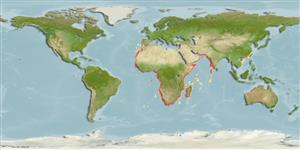Classification / Names
Common names from other countries
Main reference
Size / Weight / Age
Max length : 160 cm TL male/unsexed; (Ref. 5578)
Length at first maturity
Lm ?, range 88 - 144 cm
Environment
Marine; bathydemersal; depth range 300 - 1400 m (Ref. 247)
Climate / Range
Deep-water, preferred 27°C (Ref. 107945); 43°N - 38°S, 18°W - 124°E (Ref. 54312)
Distribution
Eastern Atlantic: Portugal, Senegal, Côte d'Ivoire to Nigeria. Western Indian Ocean: southern Mozambique and possibly Natal, South Africa (Ref. 11228). Western Pacific: China (Ref. 6577) and Taiwan (Ref. 247); occurrence in the Western Central Pacific uncertain but should be watched for (Ref. 31367). Often confused with Centrophorus niaukang and Centrophorus granulosus (Ref. 31367).
Countries | FAO areas | Ecosystems | Occurrences | Introductions
Short description
Dorsal
spines
(total): 2;
Dorsal
soft rays
(total): 0;
Anal
spines: 0;
Anal
soft rays: 0. A large, stout gulper shark with a broad snout, a long, low 1st dorsal fin and a high 2nd dorsal fin; pectoral rear tips moderately long; denticles low, flat and smooth (Ref. 5578). Pearl-grey in color (Ref. 5578).
IUCN Red List Status (Ref. 115185)
Threat to humans
Harmless
Human uses
Fisheries: minor commercial
More information
ReferencesAquacultureAquaculture profileStrainsGeneticsAllele frequenciesHeritabilityDiseasesProcessingMass conversion
Tools
Special reports
Download XML
Internet sources
Estimates of some properties based on models
Phylogenetic diversity index
PD50 = 0.5003 many relatives (e.g. carps) 0.5 - 2.0 few relatives (e.g. lungfishes)
Trophic Level
4.4 ±0.63 se; Based on food items.
Resilience
Very Low, minimum population doubling time more than 14 years (Fec=1)
Vulnerability
Very high vulnerability (87 of 100)
Price category
